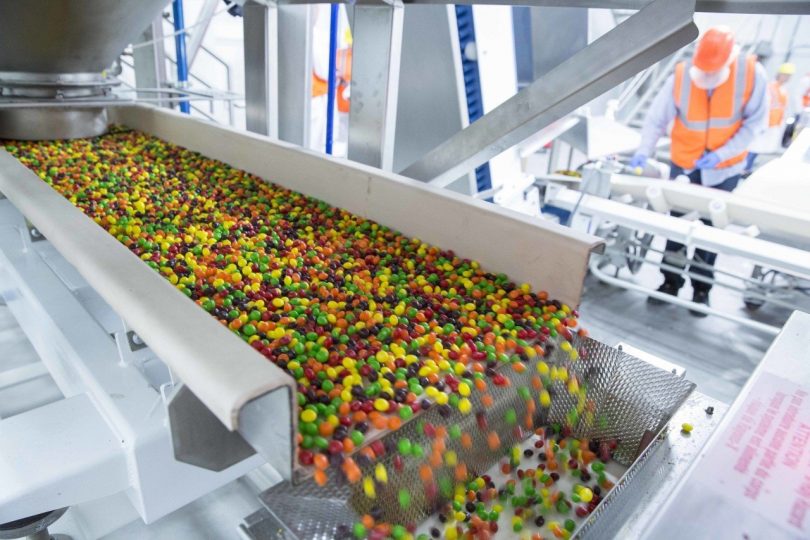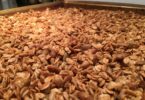On Feb. 5, 2016, Mars, Incorporated made a big promise: Within five years, it would remove artificial colors from its entire portfolio of food for people.
“Eliminating all artificial colors from our human food portfolio is a massive undertaking, and one that will take time and hard work to accomplish,” President and CEO Grant F. Reid said in the press release accompanying the announcement. “Our consumers are the boss and we hear them. If it’s the right thing to do for them, it’s the right thing to do for Mars.”
Mars’ portfolio includes Skittles, with its advertising tag line “Taste the Rainbow,” as well as Starburst and M&Ms. But it wasn’t the only one making this sort of commitment.
In June 2015, General Mills had pledged to remove artificial colors and flavors from all of its cereals, including its vivid Trix cereal and Lucky Charms with its rainbow of pastel marshmallows. According to a blog post about the commitment, the company was hoping that 90% of its cereals would be free of artificial ingredients by the end of 2016.
Kellogg made a similar promise. In an August 2015 call with investors, then-North America President Paul Norman said the company was working toward the goal of removing all artificial colors and flavors from its cereals — including its Technicolor Froot Loops and Apple Jacks cereals — and other products by 2019.
Transitioning all of these brightly hued products to natural colors could both demonstrate the quality and function of the colors of today, and move these items closer to having clean labels, made solely with ingredients consumers understand. These decisions were on pace with consumers worldwide at the time. A January 2015 Nielsen report about healthy eating trends indicated 42% of consumers worldwide found it very important that products contain no artificial colors (though just 29% in North America felt the same way).
But it didn’t happen. None of these companies met their original goals on colors. The deadlines they set for themselves came and went, and the brightest items in each company’s portfolio still get their vibrant colors from synthetic food dyes.
The reasons for stepping away from these pledges vary, but are all along common themes. Companies said they believed consumers didn’t want artificial colors in their products, but subsequent research proved otherwise. Natural colors didn’t perform the same as their artificial counterparts. Consumers were unwilling to buy formerly vibrant products with the duller natural colors.
Mars Wrigley’s Skittles roll off of a production line.
Courtesy of Mars Wrigley
But, consumer advocates say, people really do want fewer artificial colors in their food.
“It’s deeply disappointing,” said Lisa Lefferts, senior scientist at the Center for Science in the Public Interest. “I think if they wanted to meet the commitment, then they could have.”
CSPI has been advocating for artificial colors to be banned since 2008, when the group formally petitioned the Food and Drug Administration. Its reasoning was that synthetic food dyes had been linked to problems in children’s behavior since the 1970s, and evidence of the association was mounting.
CSPI’s petition led to a 2011 meeting of FDA’s Food Advisory Committee about synthetic food dyes. But the meeting led to no actions, just more studies that seem to corroborate CSPI’s position. Lefferts composed her own report on the issue in 2016.
While the federal government hasn’t taken any action on dyes, lawmakers in California have picked up the mantle. A bill proposed in 2017 to require labeling on products using artificial colors became a near-$500,000 appropriation for a comprehensive study looking into the link between artificial food dyes and children’s behavior, which was just published in April.
‘Not every consumer wants the same thing’
Most of the companies that made pledges to remove their artificial colors let their self-imposed deadlines pass without comment.
Only Mars has a statement on its website updating its initial commitment. But all of the companies told Food Dive there are still artificial colors in a percentage of their products. Kellogg is the closest to meeting its commitment, with 90% of its cereals using only natural colors. More than 85% of General Mills’ cereals use natural colors and flavors. And Mars has removed artificial colors from all of its dinnertime foods, but is not prioritizing moving to natural colors for its candies sold in North America.
In its statement, Mars said that after making its 2016 commitment, the company put significant time and money into developing new ingredients, seeking regulatory approval, working on manufacturing and looking more closely into consumer needs and expectations.
“In doing so, we have found that consumer expectations regarding colors in food differ widely across markets and categories,” the website states. “This has motivated us to reevaluate our global intent and seek to identify approaches that are more locally tailored to address these differences.”
In Europe, where consumer concern about artificial colors is greater and many products with artificial colors need to have warning labels, Mars is concentrating on removing all synthetic dyes. And, the company stresses on the website, there are several confectionery options available worldwide that do not have any artificial dyes.

Trix made with natural colors (right) and artificial colors (left) in 2017.
Courtesy of General Mills
General Mills made high-profile efforts to switch to natural colors that did not go well. In early 2016, the company changed packaging on Trix, Reese’s Puffs, Cocoa Puffs, Golden Grahams, Fruity Cheerios, Frosted Cheerios and Chocolate Cheerios to highlight that there were no longer artificial colors or flavors. At first, consumers responded positively to the change. Then-CEO Ken Powell said in an March 2016 earnings call that these seven cereal brands had seen a 6% sales bump since the reformulations, up from a 6% decrease the year before.
But things did not stay so positive. In 2017, after hearing consumer complaints and seeing sales declines, General Mills brought back Trix with artificial colors.
It turns out consumers “don’t all want one thing,” company spokesman Mike Siemienas told The Wall Street Journal at the time.
Siemienas said that General Mills also struck out with trying to find a natural color solution for Lucky Charms after spending an extensive amount of time and effort on the problem.
“In consumer testing, consumers did not like any of the options, so we did not make any changes,” he said in an email. “We have exhausted the current colors from natural sources available at this time.”
“Not every consumer wants the same thing and every product does not need to be the same. It is important to focus on the people who eat the products every day and make sure that any changes made to the products meet their needs.”

Mike Siemienas
Spokesman, General Mills
General Mills’ focus has shifted away from removing artificial colors and flavors from its products as a singular R&D target. Siemienas said the company is focused on meeting consumers’ needs, but those are not all the same. The company will continue to innovate and will update recipes when they improve products. General Mills already has several cereals that have no artificial colors and flavors, he pointed out — including Cheerios, Chex and Kix — and has launched kid-targeted cereals that contain nutrients but no artificial colors, like Sesame Street Cereal.
“Not every consumer wants the same thing and every product does not need to be the same,” Siemienas wrote. “It is important to focus on the people who eat the products every day and make sure that any changes made to the products meet their needs.”
As for Kellogg, spokesperson Kris Bahner said in an email that 90% of the company’s branded cereals, snack bars and Eggo waffles don’t have artificial colors or flavors as a result of its push toward natural reformulaton.
“We use artificial ingredients in some foods to provide the great taste and quality consumers expect and appreciate while continuing to provide a wide variety of choices,” she said. “We will continue to leverage the best available science ensuring our foods are safe, and transparently label our foods.”
‘Major CPGs put the brakes on large-scale conversions’
From these unfinished commitments, it may appear that CPG companies have stopped being concerned with artificial colors. David Rigg, global food marketing director for Sensient Food Colors, said that is not the case.
“About 80% of new products introduced in the U.S. — and in fact, that happens to be similar globally — they use colors from natural sources,” Rigg said. “…What’s really happened is that the major CPGs sort of put the brakes on large-scale conversions.”
And those conversions, where a known product is reformulated without artificial colors, haven’t stopped either, Rigg said. Manufacturers are still interested in moving existing products to using natural colors, and they begin these conversations aware of some of the limitations. However, when there’s a new product coming on the market, consumers won’t notice if it looks different or is more expensive, he said.
While artificial coloring is basically many combinations of the six well-known synthetic dyes approved by the FDA, natural colors are much more varied in hue, function and behavior, Rigg said. But, in most cases, there are natural colors available today that can achieve the same degree of vibrancy as synthetic ones. In some instances, like purple hues, natural colors are actually superior to artificial ones, Rigg said.

A portfolio of Sensient’s natural beverage colors.
Permission granted by Sensient
Natural colors’ behavior differs by product type. They may become less stable in food or beverages with different pH values, and could react to light and heat. Rigg said that Sensient has been able to figure out how to get around some of these challenges, but conversations with customers are very dependent on what their products are, what the packaging is like, and what they hope the dyes will do. For example, he said, a green icing made with yellow coming from turmeric may not last in a package with a clear window because the color isn’t stable with light exposure. Most of Sensient’s color R&D is around making better greens and blues that will remain stable in different applications, Rigg said.
There’s also the cost involved in using natural colors, Rigg said. To make a product more vibrant using a natural color, more is usually needed, driving costs up.
“It’s not that natural colors are that expensive. But synthetic colors are incredibly cost effective,” Rigg said. “In most formulations — virtually all, in fact — using synthetic color is some insignificant part of the total formulation cost. And when you move to natural colors, it looks a lot more like [the cost of] a flavor. So it’s not necessarily prohibitive, but it’s a big jump from where you used to be.”
As with other reformulations, Rigg said, consumers may not understand why a product that has been remade with natural colors would suddenly cost more. And, while some manufacturers may have used similar tactics to keep consumer price increases down when other commodity prices go up, like decreasing pack sizes, Rigg doesn’t know of any manufacturer that has been able to justify a price increase simply by using natural colors. And, he said, blues and greens tend to be some of the priciest natural colors.
Companies that make food dyes aren’t the only ones putting R&D effort into natural colors. Mars funded a decade-long research project that found a natural blue colorant in red cabbage. According to the findings, published in April in the Science Advances journal, this color has properties that are nearly identical to the synthetic industry standard, FD&C Blue No. 1. This new blue is still a distance away from finding its way into food. In April, Mars still needed to do product and application-specific testing and submit the new color to the FDA for approval.
“It’s not that natural colors are that expensive. But synthetic colors are incredibly cost effective. … So it’s not necessarily prohibitive, but it’s a big jump from where you used to be.”

David Rigg
Global food marketing director, Sensient Food Colors
While CPG companies have defended their stepping away from a natural color transition by saying it isn’t as important of an issue for consumers, Rigg said it isn’t quite that simple.
“I would say about 60% care and will change their purchase behavior,” Rigg said. “But if you have a product category that taps into a need state where they’re not thinking about things like artificial colors, or a consumer segment that is unconcerned, then there isn’t a lot of motivation to change.”
Bringing in the science
As manufacturers consider their options, there is the risk that legislators or regulators will force their hand. California state Sen. Bob Wieckowski has been looking at artificial colors and their impact on consumers for years.
Soon after he was elected to office, Wieckowski began working with the California Council on Science & Technology’s Science Fellows program, which places Ph.D-level scientists in different disciplines in state legislators’ offices.

Marshmallows in Lucky Charms cereal.
Through the years. Wieckowski has worked with several scientists who told him about concerns the scientific community has had with synthetic food dyes. Many independent studies appeared to show a connection between artificial food colors and the behavior of children and animals, but FDA and other regulators in the United States had not made any policy changes. In the meantime, international regulators — including in Europe — had used this research to prohibit some dyes in food and drink, as well as create a labeling regime to warn consumers that products containing artificial dyes could have a negative effect on children’s behavior.
“When it comes to food dyes, we just never had any labels, so the consumer is left in the dark,” Wieckowski said. “We talked about it and came up with this idea of just having a warning label back in 2017.”
Wieckowski’s bill, which would require a label telling consumers that synthetic dyes can cause behavior problems or hyperactivity in children, did not become law. However, Wieckowski is a member of the Budget and Fiscal Review Committee, and was able to appropriate almost $500,000 for a comprehensive study looking into the topic as part of the state’s 2018 budget.
The study was done by California’s Office of Environmental Health Hazard Assessment (OEHHA), which is a division of the state’s Environmental Protection Agency. OEHHA is responsible for administering Proposition 65, the state law requiring warnings for chemicals that could cause cancer, birth defects and other harm.
OEHHA led a comprehensive and multiyear process, taking a deep dive into the issue and having its findings peer reviewed. The agency started out with a two-day symposium in 2019, inviting experts to talk about artificial colors and research, said OEHHA Deputy Director for Scientific Affairs Melanie Marty, who was one of the lead authors of the study. Then they did a deep literature and scientific review and spent more than a year writing a draft of their findings, which connected all of the research into a single report. The draft was peer reviewed and opened to comments from the public. The final draft was published in April.
The top finding, Marty said, is that artificial colors in food can impact children’s behavior, a theme that ran through the many previous studies.
“The types of effects that we’re seeing were hyperactivity, restlessness, irritability, and those were noted by parents and teachers, and also in some of the better conducted studies, objective measures where the children get computer tests and that’s how you can measure whether or not they’re attentive,” she said.
Studies that looked at animals that had been given synthetic dyes also showed neurological effects from exposure to the dyes, further supporting the conclusion, Marty said.
“What we hope with the industry is that they say, ‘The better practice is, we don’t need the warning on our food because we’re going to take that out.’ “

California state Sen. Bob Wieckowski
Wieckowski waited until the study was complete to propose his bill again. He submitted it this year, but pulled it back in April to allow his colleagues the opportunity to read, digest and understand the study. The bill will be up for consideration in 2022.
Wieckowski is optimistic that his colleagues will support legislation to establish the warning label next year. The science behind the report is both clear and solid, he said. And if California passes this labeling law, it may start a chain reaction in other statehouses, he said.
“I think the national players and other state houses are watching to see, ‘OK, how much opposition are they going to get?’ “ Wieckowski said.
Lefferts from CSPI said that organization has not yet decided how it is going to use the study to mobilize policy change on the state and national level. Lefferts praised the report for using clear science to show why artificial colors shouldn’t be in food.
A state labeling law could also motivate FDA or Congress to make a national change, which could standardize a warning for products in all states. Similar policy action happened in 2016, when a wave of state-specific laws mandating GMO labeling passed, forcing the federal government to put a superseding policy in place.

Confections using Sensient’s natural colors.
Permission granted by Sensient
FDA has no plans right now to change federal policy on artificial colors, an agency spokesperson said in an email. It is continuing to review the California study, and the agency would not comment on the state’s pending legislation.
“The FDA will continue to engage in the scientific and regulatory review of color additives to evaluate their potential impact on various populations, including children, and act when necessary to ensure that the products marketed to consumers are safe and properly labeled,” the agency said.
The International Association of Color Manufacturers, which represents both companies that make food dyes and the manufacturers that use them, argued in a written statement that the study doesn’t establish a direct relationship between use of synthetic food dye and behavioral problems in children and “its conclusion that an association may exist are based on insufficient scientific evidence.”
“A warning statement based on inconclusive science would not provide meaningful impact to Californians but would mislead consumers and undermine consumer confidence in a safe food supply,” the group’s statement says. “Parents of children who may be sensitive to food ingredients, including colors, can avoid such foods in consultation with their doctor based on existing ingredient declarations and labeling requirements.”
Peer reviews from three epidemiologists who specialize in the field did not find a lack of causality in the California study.
Wieckowski hopes that once the contents of the study are understood, legislation and policy changes are not needed to get artificial colors out of food. Mars, General Mills and Kellogg had no comment on the California study.
“What we hope with the industry is that they say, ‘The better practice is, we don’t need the warning on our food because we’re going to take that out,’ ” Wieckowski said.








